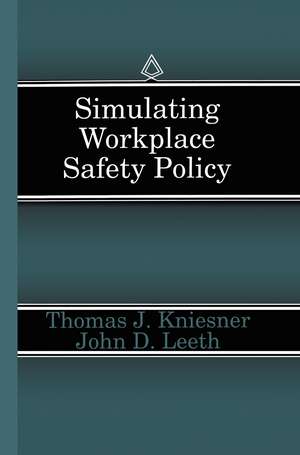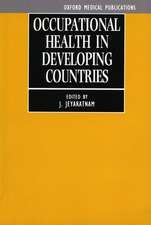Simulating Workplace Safety Policy: Studies in Risk and Uncertainty, cartea 6
Autor Thomas J. Kniesner, John D. Leethen Limba Engleză Paperback – 27 sep 2012
| Toate formatele și edițiile | Preț | Express |
|---|---|---|
| Paperback (1) | 941.68 lei 6-8 săpt. | |
| SPRINGER NETHERLANDS – 27 sep 2012 | 941.68 lei 6-8 săpt. | |
| Hardback (1) | 947.67 lei 6-8 săpt. | |
| SPRINGER NETHERLANDS – 31 dec 1994 | 947.67 lei 6-8 săpt. |
Din seria Studies in Risk and Uncertainty
-
 Preț: 104.32 lei
Preț: 104.32 lei -
 Preț: 393.74 lei
Preț: 393.74 lei - 18%
 Preț: 953.03 lei
Preț: 953.03 lei - 15%
 Preț: 647.08 lei
Preț: 647.08 lei - 18%
 Preț: 1491.25 lei
Preț: 1491.25 lei - 15%
 Preț: 641.38 lei
Preț: 641.38 lei - 15%
 Preț: 633.02 lei
Preț: 633.02 lei - 15%
 Preț: 640.24 lei
Preț: 640.24 lei - 15%
 Preț: 645.47 lei
Preț: 645.47 lei - 18%
 Preț: 1224.06 lei
Preț: 1224.06 lei - 15%
 Preț: 638.89 lei
Preț: 638.89 lei - 18%
 Preț: 950.66 lei
Preț: 950.66 lei - 18%
 Preț: 946.24 lei
Preț: 946.24 lei - 18%
 Preț: 954.93 lei
Preț: 954.93 lei - 15%
 Preț: 640.24 lei
Preț: 640.24 lei
Preț: 941.68 lei
Preț vechi: 1148.40 lei
-18% Nou
Puncte Express: 1413
Preț estimativ în valută:
180.19€ • 188.64$ • 149.10£
180.19€ • 188.64$ • 149.10£
Carte tipărită la comandă
Livrare economică 05-19 aprilie
Preluare comenzi: 021 569.72.76
Specificații
ISBN-13: 9789401042833
ISBN-10: 9401042837
Pagini: 236
Ilustrații: XVII, 215 p.
Dimensiuni: 155 x 235 x 12 mm
Greutate: 0.34 kg
Ediția:Softcover reprint of the original 1st ed. 1995
Editura: SPRINGER NETHERLANDS
Colecția Springer
Seria Studies in Risk and Uncertainty
Locul publicării:Dordrecht, Netherlands
ISBN-10: 9401042837
Pagini: 236
Ilustrații: XVII, 215 p.
Dimensiuni: 155 x 235 x 12 mm
Greutate: 0.34 kg
Ediția:Softcover reprint of the original 1st ed. 1995
Editura: SPRINGER NETHERLANDS
Colecția Springer
Seria Studies in Risk and Uncertainty
Locul publicării:Dordrecht, Netherlands
Public țintă
ResearchCuprins
1 Introduction.- Why OSHA Did Not Prevent the Tragic Fire.- U.S. Workplace Injuries and Illnesses.- Workplace Safety Programs in the United States.- Econometrically Studying Job Safety.- The Simulation Approach to Studying Job Safety.- Summary of Key Simulation Results.- Notes.- 2 The Economics of Workplace Safety.- Labor Market Equilibrium with Work-Related Health Hazards.- Workplace Safety Policy.- The Need for Numerical Simulation Research.- Conclusion.- Notes.- 3 The Simulation Model.- A Mathematical Description of Hedonic Labor Market Equilibrium.- Numerical Simulation Techniques.- Parameterizing the Simulation Model.- Initial Numerical Simulation Results.- Sensitivity Checks.- Calibrating the Simulation Model.- Conclusion.- Appendix 3A: Mathematical Derivation of the Continuous Model.- Appendix 3B: Structural Equations and Initial Parameter Values.- Notes.- 4 The Safety Policy System.- Numerical Simulation Details.- Numerical Simulation Results.- Two Possible Refinements in WC and OSHA.- Conclusion.- Appendix 4A: Structural Equations and Initial Parameter Values.- Notes.- 5 Asymmetric Information Problems in Workers’ Compensation Insurance.- Labor Market Equilibrium.- Numerical Simulation Details.- Numerical Simulation Results.- Conclusion.- Notes.- 6 Policy Implications.- OSHA During the 1970s Versus the 1980s.- Reforming OSHA.- Workers’ Compensation Insurance and Safety.- Reforming Workers’ Compensation.- Conclusion.- Notes.- References.





















